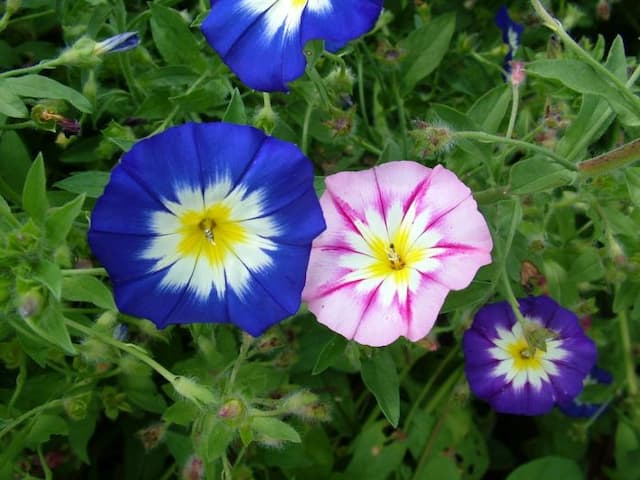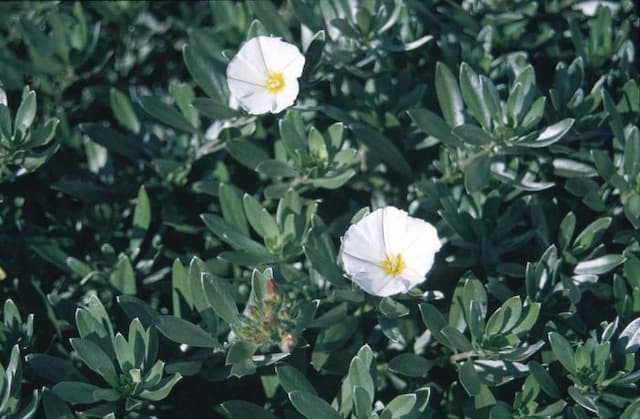Morning Glory Ipomoea purpurea

ABOUT
The Morning Glory is known for its vibrant and funnel-shaped flowers that typically come in a variety of shades such as purples, blues, pinks, and sometimes whites. The heart-shaped leaves of this plant add to its overall aesthetic, making it a favorite among garden enthusiasts. The blossoms usually have a delicate and slightly pleated appearance, often featuring a white throat that transitions to the main color of the flower. These radiant flowers bloom in the morning, thus giving the plant its common name, and close up in the afternoon or evening. Each flower is usually short-lived, lasting for just a single day, but the plant itself is prolific and produces new blooms daily throughout its blooming season. The twining stems and the vine-like growth habit of the Morning Glory allow it to climb and sprawl over structures and other plants with the help of supportive trellises or other surfaces to cling to. The overall appearance of the Morning Glory is one that signifies the beauty and ephemeral nature of life, providing a lush and colorful display that renews itself each day.
About this plant
 Names
NamesFamily
Convolvulaceae
Synonyms
Common Morning Glory, Tall Morning Glory, Purple Morning Glory, Grandpa Ott's Morning Glory
Common names
Convolvulus purpureus, Ipomoea hirsutula, Ipomoea purpurea var. diversifolia, Ipomoea purpurea var. glandulifera, Ipomoea purpurea var. minor, Ipomoea purpurea var. multicaulis, Ipomoea tiliacea, Pharbitis diversifolia, Pharbitis hirsutula, Pharbitis hispida, Pharbitis purpurea.
 Toxicity
ToxicityTo humans
Common Morning Glory has been known to contain toxic compounds, including lysergic alkaloids, which are similar in structure to LSD. However, it is generally considered to have low toxicity for humans. Ingesting the seeds in large quantities can potentially cause hallucinations, nausea, diarrhea, and vomiting due to these compounds. Additionally, they may cause an elevated heart rate, increased blood pressure, and potential harm if consumed in excessive amounts.
To pets
Common Morning Glory can be toxic to pets, including dogs and cats. The seeds contain the highest concentration of toxic alkaloids. If pets consume a large number of seeds, they might experience gastrointestinal upset, which can manifest as vomiting, diarrhea, or abdominal pain. In some cases, ingesting large amounts of seeds could lead to more severe symptoms like tremors, disorientation, or ataxia. It's essential to keep pets away from the plant, especially the seeds, to avoid potential poisoning.
 Characteristics
CharacteristicsLife cycle
Annuals
Foliage type
Deciduous
Color of leaves
Green
Flower color
Varies
Height
6-10 feet (1.8-3 meters)
Spread
3-6 feet (0.9-1.8 meters)
Plant type
Climber
Hardiness zones
6
Native area
Central America
Benefits
 General Benefits
General Benefits- Ornamental Value: Ipomoea purpurea, commonly known as Morning Glory, is well-regarded for its vibrant, trumpet-shaped flowers that can enhance the aesthetic appeal of gardens and landscapes.
- Pollinator Attraction: The bright and nectar-rich flowers of the Morning Glory attract bees, butterflies, and hummingbirds, aiding in pollination.
- Privacy Screening: With its rapid and dense growth, Morning Glory can be used to create natural screens for privacy or to conceal unsightly areas.
- Soil Erosion Control: Morning Glory's extensive root system helps stabilize soil and prevent erosion, particularly on slopes or banks.
- Shade Provision: The dense foliage of Morning Glory can provide cooling shade when grown over pergolas or trellises, reducing local temperatures.
- Cultural Significance: Morning Glories have various symbolic meanings in different cultures and can be used in gardens for cultural or spiritual purposes.
- Wildlife Habitat: The dense vines can provide shelter for small wildlife such as birds and beneficial insects.
- Quick Coverage: Morning Glory vines grow very quickly, ideal for covering fences, walls, or other structures in a short period.
- Adaptability: It is adaptable to a variety of soil conditions and climates, making it accessible for a wide range of gardeners.
- Educational Use: The fast growth and visible floral development make Morning Glory suitable for educational projects on plant growth and biology.
 Medical Properties
Medical Properties- This plant is not used for medical purposes.
 Air-purifying Qualities
Air-purifying QualitiesThis plant is not specifically known for air purifying qualities.
 Other Uses
Other Uses- Ornamental Use: Ipomoea purpurea, commonly known as morning glory, is widely cultivated for its vibrant flowers that can brighten up trellises, arbors, and fences.
- Educational Tool: Morning glory can be used in biology classes to demonstrate plant growth patterns, twining, and the effects of light on plant behavior.
- Ink Production: The flowers of morning glory can be used to obtain a natural purple dye, which can be used for crafting inks or fabric dyes.
- Privacy Screens: The dense foliage and rapid growth of morning glory make it an ideal plant for creating quick, natural privacy screens in gardens or on balconies.
- Sacred Symbolism: In some cultures, morning glory is a symbol of love and affection, and it is used in various ceremonies and rituals to represent these emotions.
- Photography Subject: With its stunning blooms, morning glory often serves as an excellent subject for photography enthusiasts looking to capture the beauty of nature.
- Companion Planting: Morning glory can be used in companion planting to improve the visual appeal of vegetable gardens and to provide support structures for climbers like beans and peas.
- Butterfly Attraction: The nectar of the morning glory flower attracts butterflies, making it an ideal choice for butterfly gardens.
- Erosion Control: Because of its dense growth and extensive root system, morning glory can be planted on slopes to help prevent soil erosion.
- Education on Invasiveness: In areas where it is considered invasive, morning glory can be used to educate the public on the importance of managing invasive species and promoting native biodiversity.
Interesting Facts
 Feng Shui
Feng ShuiThe Morning Glory is not used in Feng Shui practice.
 Zodiac Sign Compitability
Zodiac Sign CompitabilityThe Morning Glory is not used in astrology practice.
 Plant Symbolism
Plant Symbolism- Morning Glory (Ipomoea purpurea) - Symbolizes love, affection, and unrequited love. This is due to the flower's short-lived but beautiful blossoms that open in the morning and die by the afternoon, reflecting love that may not last.
- Mortality - The morning glory's daily regeneration is often associated with the cycle of life and death, serving as a reminder of our mortality.
- Resilience and Renewal - As the morning glory blooms afresh each day, it represents a spirit of resilience and the idea of starting over or new beginnings.
- Victory over Hardship - The plant’s ability to grow and flourish in difficult environments symbolizes overcoming challenges or obstacles.
 Water
WaterMorning Glory likes to be kept consistently moist, but not waterlogged. Generally, it is best to water the Morning Glory once a week with approximately 1 inch of water. Use a soaker hose or drip irrigation to apply water directly to the soil to avoid wetting the foliage, which can lead to fungal diseases. During hot, dry periods, increase watering to twice a week. Cut back on watering as the weather cools to help harden off the plants before the first frost.
 Light
LightMorning Glory thrives in full sun conditions, requiring a minimum of 6 hours of direct sunlight daily to perform at its best. It should be placed in a spot where it can receive abundant sunshine throughout the day. Avoid heavily shaded areas, as this can lead to poor flowering and a lanky growth habit.
 Temperature
TemperatureMorning Glory prefers warm temperatures and can thrive in conditions between 65 to 85 degrees Fahrenheit. It can survive minimum temperatures down to around 45 degrees Fahrenheit, but frost can be detrimental. For optimal growth, keep the plant in an area where the temperature does not drop below 50 degrees Fahrenheit at night.
 Pruning
PruningPruning Morning Glory is essential for maintaining its shape and encouraging bushier growth. Prune sparingly and only to remove dead or overgrown stems. Ideally, light pruning should be done throughout the growing season as necessary. The best time for more extensive pruning is in the late winter or early spring before new growth begins.
 Cleaning
CleaningAs needed
 Soil
SoilThe Morning Glory prefers a well-draining soil rich in organic matter with a pH ranging from 6.0 to 7.5. A mix of loam, peat, and sand or perlite in equal parts can be ideal.
 Repotting
RepottingMorning Glories are typically grown as annuals and do not usually require repotting. If grown as perennials, repotting every 2-3 years is sufficient.
 Humidity & Misting
Humidity & MistingMorning Glories thrive in moderate humidity levels but are adaptable and can tolerate a wide range of conditions, making them ideal for various environments.
 Suitable locations
Suitable locationsIndoor
Use bright, indirect light and a trellis.
Outdoor
Plant in full sun, provide support for climbing.
Hardiness zone
3-10 USDA
 Life cycle
Life cycleMorning Glory (Ipomoea purpurea) begins its cycle when seeds germinate in warm, moist soil, generally in the spring. Following germination, seedlings emerge and establish a small root system and cotyledons (seed leaves) before developing true leaves. As the plant grows, it develops a climbing vine with heart-shaped leaves, using tendrils to grasp onto supports. Throughout the summer, the vine produces trumpet-shaped flowers that open in the morning and close in the afternoon, typically starting to bloom within 6-8 weeks after planting. After pollination, often by bees and hummingbirds, the flowers produce fruit that contains seeds. The seeds can remain dormant in the soil over the winter and germinate the next spring, continuing the cycle.
 Propogation
PropogationPropogation time
Spring-Early Summer
Propogation: The most popular method of propagation for the Morning Glory (Ipomoea purpurea) is by seed. The ideal time to sow Morning Glory seeds is in the spring after the last frost when soil temperatures have warmed to at least 64 degrees Fahrenheit (18 degrees Celsius). To encourage germination, it's common to nick the hard seed coat with a file or soak the seeds in water for 24 hours prior to planting. Seeds should be planted about 1/4 inch (6 millimeters) deep in well-draining soil and spaced 6 to 12 inches (15 to 30 centimeters) apart to allow for ample growing space. Morning glories are climbers and should be provided with a structure to climb, such as a trellis or fence, as soon as they are tall enough to reach. With adequate sunlight, water, and patience, seedlings will emerge in one to three weeks, eventually producing vibrant trumpet-shaped flowers.









